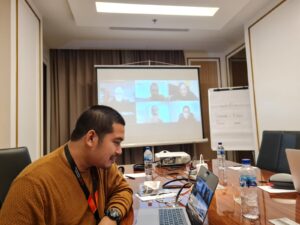TR43 vol 14 no 4 of the Mathematics Teaching-Research Journal
Editorial from Rully Charitas Indra Prahmana, Southeast Asia Editor of MTRJ
 Mathematics is a scientific field that can be taught with various approaches, methods, models, and strategies. Mathematics can also be taught by integrating the latest Information and Communications Technology (ICT). Although mathematics is taught using ICT integration (both in learning activities and assessment), the meaningfulness of mathematics can still be obtained by students through the provision of various contextual problems that are close to students’ daily lives. In addition to the application of ICT, strengthening student activities in mathematics learning is also the most important part of optimizing the effectiveness of mathematics learning. Student activities in mathematics learning can also be optimized using the Ethnomathematics approach, which uses cultural contexts in mathematics. Therefore, in Vol. 14 No. 4, Fall 2022, MTRJ publishes 12 articles that present different research results on learning mathematics using various approaches, methods, models, and strategies by optimizing student learning activities. In this issue, we also publish one article published in Problem Corner section created by the Problem Corner Editor, namely Ivan Retamoso.
Mathematics is a scientific field that can be taught with various approaches, methods, models, and strategies. Mathematics can also be taught by integrating the latest Information and Communications Technology (ICT). Although mathematics is taught using ICT integration (both in learning activities and assessment), the meaningfulness of mathematics can still be obtained by students through the provision of various contextual problems that are close to students’ daily lives. In addition to the application of ICT, strengthening student activities in mathematics learning is also the most important part of optimizing the effectiveness of mathematics learning. Student activities in mathematics learning can also be optimized using the Ethnomathematics approach, which uses cultural contexts in mathematics. Therefore, in Vol. 14 No. 4, Fall 2022, MTRJ publishes 12 articles that present different research results on learning mathematics using various approaches, methods, models, and strategies by optimizing student learning activities. In this issue, we also publish one article published in Problem Corner section created by the Problem Corner Editor, namely Ivan Retamoso.
This issue opens with a paper written by Indonesian researchers Abdul Taram and Fariz Setyawan from Ahmad Dahlan University, Yogyakarta, Indonesia, with the title Stress Tolerance in Probabilistic Thinking: A Case Study. This research explores students works which scored highest on the stress tolerance dimension could solve problems with simple steps. These findings show that the level of probabilistic thinking depends on students’ stress tolerance.
The second paper continues with a study that applied play in learning numerical sense for primary school students. Selepe Mmakgabo Angelinah and Mphahlele Ramashego Shila from the University of Free State and the University of South Africa, South Africa, present an article entitled The Viability of Play in Teaching Number Sense to Grade 3 Learners. This research offers the use of play in teaching number sense to Grade 3 learners through simple yet quality materials. The research also recommends using indigenous games that are easy to find as a medium for learning numbers.
In this issue, MTRJ publishes two papers that were analyzed using Rasch Measurement analysis. In the first paper, Rahmi Ramadhani, Nuraini Sri Bina, and Edi Syahputra from Universitas Negeri Medan and Universitas Potensi Utama, Medan, Indonesia writes the first Rasch analysis paper with the title Flipped Classroom Assisted Autograph in Calculus Learning for Engineering Students: A Rasch Measurement Study. This research analyzes calculus learning for engineering students using an Autograph-based Flipped Classroom. Integrating Autograph as ICT media helps engineering students understand Calculus material. The Rasch Measurement-Stacking Analysis results show a change in the logit value of each student’s test results. This result shows that the mathematics learning achievement of engineering students increased, and students gave positive feedback after being taught using the Flipped Classroom model assisted by Autograph.
Furthermore, in the second Rasch analysis paper, Suherman and Tibor Vidákovich from the University of Szeged, Hungary presents a paper that used Rasch Measurement analysis in analyzing students’ creative thinking ability through learning tapis pattern mathematics in the context of Ethnomathematics. The paper entitled Tapis Patterns in the Context of Ethnomathematics to Assess Students’ Creative Thinking in Mathematics: A Rasch Measurement discuss the Tapis Lampung design used includes geometry concepts that can be used in measuring students’ creative thinking skills. Each Tapis pattern also includes local values (i.e., sacred value, social stratification, history and understanding, creativity, inclusivity, and economic value).
The use of technology in mathematics learning is also used in the next article by Ana Katalenić and Zdenka Kolar-Begović from the University of Osijek, Croatia, with the title Prospective Primary School Teachers’ Work in Continuous Online Assessments in the Course of Didactics of Mathematics. This research applies online assessment to the effectiveness of blended learning conducted by prospective primary school teachers. This research is an evaluation conducted during emergency distance learning due to the Covid-19 Pandemic. The findings show that students’ learning approaches were strategic and relied heavily on peer support. The results of this research may influence the design of future continuous assessments in blended learning for prospective primary school teachers.
Investigation of students’ activities is the focus of further research offered in the next article by Muhammad Daut Siagian, Didi Suryadi, Elah Nurlaelah, Sufyani Prabawanto from Universitas Pendidikan Indonesia and Universitas Islam Sumatera Utara, Indonesia, entitled Investigation of Secondary Students’ Epistemological Obstacles in the Inequality Concept. This research explores the epistemological obstacles students face in the inequality concept by analyzing the errors in solving inequality problems. The results show that there are obstacles experienced by students, which are shown by students’ limitations in understanding and interpreting inequality signs in solving inequality problems.
The next paper was written by Hashituky Telesphore Habiyaremye, Celestin Ntivuguruzwa, and Philothere Ntawiha from the University of Rwanda College of Education (URCE), Rwanda, with the title Assessment of Teaching Methods in Mathematical Simplicity and Complexity in Rwandan Schools via Pedagogical Content Knowledge. This research focuses on assessing the practice of Rwandan mathematics teachers through strengthening pedagogical content. The results find a lack of mastery of content and specialized knowledge at the university level was the cause of low teacher performance. The research recommends providing training in content knowledge to strengthen the teaching practices of teachers, especially those from teacher training colleges.
The next two papers focus on the competencies of prospective and mathematics teachers. The paper entitled The Investigation of Concept Image towards Derivative Representation: A Case Study of Prospective Mathematics Teacher was written by Aditya Prihandhika, Didi Suryadi, Sufyani Prabawanto from Universitas Pendidikan Bandung and Universitas Islam Al-Ihya Kuningan, Indonesia. This research presents a qualitative research design that investigates the conceptual description of prospective teachers in derivative representation. The results show the conceptual description of all participants on the concept of derivatives was still limited to the representation of functions.
Furthermore, María Burgos Navarro and María José Castillo Céspedes from the University of Granada, Spain, and the University of Costa Rica, Costa Rica, present their research entitled Developing reflective competence in pre-service teachers by analyzing textbook lessons: the case of proportionality. This study describes the implementation and outcomes of training actions with 45 pre-service teachers to develop reflective competence by analyzing the didactical appropriateness of a lesson on direct proportionality. The implementation results show the evolution of reflective competence in most pre-service teachers, who could make detailed judgments by correctly applying the appropriateness criteria, especially in the cognitive-affective and instructional dimensions.
The last three papers focus on the development of teaching materials and exploring alternative solution for some calculus problem. The first paper entitled The Development of Inquiry-Based Teaching Materials for Basic Algebra Courses: Integration with Guided Note-Taking Learning Models written by Merina Pratiwi, Dewi Yuliana Fitri, and Anna Cesaria from the University of PGRI West Sumatra, Indonesia. This research produces inquiry-based learning tools with guided notes for Basic Algebra courses that are valid, effective, and practical. Furthermore, Tria Gustiningsi and colleagues from Sriwijaya University, Indonesia, produce a jumping task in the form of a valid and practical student worksheet through research entitled Designing Student Worksheet on Relation and Function Material for Mathematics Learning: Jumping Task. The results show that the designed student worksheet could help students understand the instructions or questions in the student worksheet and could be used by students. Lastly, the paper entitled Heuristic Method for Minimizing Distance without using Calculus and Its Significance written by Ivan Retamoso from Borough of Manhattan Community College of the City University of New York, USA. In this paper, he provides alternatives for solving some Applied Optimization Problems related to minimizing a distance, without the use of the Derivative from Calculus, and instead, using a “Reflection Principle” based on symmetry, Geometric properties, and heuristic methods.
Rully Charitas Indra Prahmana
Southeast Asia Editor of MTRJ
Contents
Stress Tolerance in Probabilistic Thinking: A Case Study
Abdul Taram and Fariz Setyawan, Indonesia
The Viability of Play in Teaching Number Sense to Grade 3 Learners
Selepe Mmakgabo Angelinah and Mphahlele Ramashego Shila, South Africa
Flipped Classroom Assisted Autograph in Calculus Learning for Engineering Students: A Rasch Measurement Study
Rahmi Ramadhani, Nuraini Sri Bina, and Edi Syahputra, Indonesia
Tapis Patterns in the Context of Ethnomathematics to Assess Students’ Creative Thinking in Mathematics: A Rasch Measurement
Suherman, Indonesia, and Tibor Vidákovich, Hungary
Prospective Primary School Teachers’ Work in Continuous Online Assessments in the Course of Didactics of Mathematics
Ana Katalenić and Zdenka Kolar-Begović, Croatia
Investigation of Secondary Students’ Epistemological Obstacles in the Inequality Concept
Muhammad Daut Siagian, Didi Suryadi, Elah Nurlaelah, and Sufyani Prabawanto, Indonesia
Assessment of Teaching Methods in Mathematical Simplicity and Complexity in Rwandan Schools via Pedagogical Content Knowledge
Hashituky Telesphore Habiyaremye, Celestin Ntivuguruzwa, and Philothere Ntawiha, Rwanda
The Investigation of Concept Image towards Derivative Representation: A Case Study of Prospective Mathematics Teachers
Aditya Prihandhika, Didi Suryadi, and Sufyani Prabawanto, Indonesia
Developing Reflective Competence in Preservice Teachers by Analysing Textbook Lessons: The Case of Proportionality
María Burgos Navarro, Spain, and María José Castillo Céspedes, Costa Rica
The Development of Inquiry-Based Teaching Materials for Basic Algebra Courses: Integration with Guided Note-Taking Learning Models
Merina Pratiwi, Dewi Yuliana Fitri, and Anna Cesaria, Indonesia
Designing Student Worksheet on Relation and Function Material for Mathematics Learning: Jumping Task
Tria Gustiningsi, Ratu Ilma Indra Putri, Zulkardi, Diah Kartika Sari, Leni Marlina, Dewi Rawani, Arika Sari, Zahara Luthfiya Azmi, Delia Septimiranti, and Lisnani, Indonesia
Heuristic Method for Minimizing Distance without using Calculus and Its Significance
Ivan Retamoso, USA
The Problem Corner
Ivan Retamoso, USA



